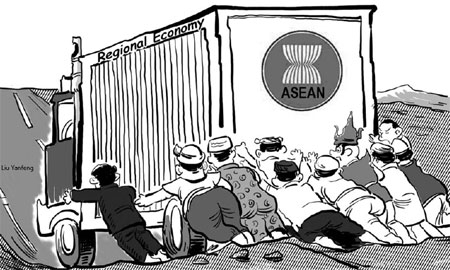
|
OPINION> Commentary
 |
|
ASEAN draws lessons from school of hard knocks
By Zhai Kun (China Daily)
Updated: 2009-03-10 07:46 The long-anticipated 14th Summit of the Association of South East Asian Nations (ASEAN), supposed to open in Bangkok at the end of December, was rescheduled to be held in the Thai seaside resort of Hua Hin from Feb 27 to March 1. Themed as "ASEAN Charter for ASEAN Peoples", this year's summit intended to clear all the barriers thwarting its development, driving towards a roadmap for all member countries. In recent years, ASEAN and its member countries have been involved in another round of chaos. Summit host Thailand was forced to postpone the opening of the summit several times because of confrontations and the endless domestic protests since the military coup after September 2006. Malaysia, as well, was trapped in a political disturbance of its own.
But the member countries have suffered more than just political chaos. After soaring inflation in some regions and Vietnam's financial pain last year, these export-driven economies as a whole once again are floundering amid a global financial Tsunami; even Singapore is in recession. Therefore, a series of questions have been raised: Can this ASEAN Charter be soundly fulfilled before 2015? Can ASEAN members achieve collective strength to combat the global financial storm? And regarding everlasting efforts to collaborate with other regions and organizations is ASEAN skillful enough to manage the "10+1" or "10+3" model and further coordinate with other East Asian countries? In Short, is the Hua Hin summit a real hope for the future? Some critics and scholars are skeptical about the answer. But at least, the recently concluded summit talks demonstrate the endeavors that ASEAN countries have made to clear out all barriers . In order to speed up the member countries' integration, 10 attending leaders, for the first time in history, convened in the opening ceremony and chanted the ASEAN Anthem together. Just as the lyrics go, they decided to gather "together for ASEAN, dare to dream", for "that is the way of ASEAN". Besides singing the anthem to boost the morale, several important statements were issued on the talks. The Hua Hin Declaration on the Roadmap for the ASEAN Community (2009-2015), comprising three pillars of building a political-security community, economic community and socio-cultural community, was signed by the 10 Southeast Asian leaders. And after releasing the ASEAN Economic Community Blueprint in 2008, two blueprints on political security and social culture were added at this year's summit, which altogether mapped out a practical plan for ensuring the establishment of an ASEAN community before 2015. In order to regain the leadership of Southeast Asia, ASEAN is adopting tangible measures to mobilize each individual power, enforce coordination and upgrade their collective capability to survive hard times. And these measures include: standing firm against the financial crisis with a new ASEAN proposal and be ready for the upcoming G20 summit with their own stand point; sign a free trade agreement with Australia and New Zealand, thus reiterate its resolute position against protectionism; agreeing to establish a pool of foreign reserves co-managed by ASEAN along with China, Japan and South Korea as soon as possible in order to defend their currencies from the ups-and-downs of the global financial market.
 And in order to win support from those big nations, the Chinese Ambassador to ASEAN and his US counterpart were invited to attend the summit's opening ceremony. In fact, last year the US was the first to send an ambassador to the ASEAN secretariat, followed by China appointing Xue Hanqin as its first ambassador to ASEAN. This year, they both showed up at talks and expressed their insight into measures to improve collaboration respectively. Scot Marciel, the US ambassador, said the US would be delighted to have opinions and suggestions from ASEAN on how to further their cooperation, while Xue also suggested that more interaction and contact would be welcomed. The ASEAN group has already gained invaluable lessons and experiences tackling similar problems stemming from a financial crisis. Southeast Asian countries suffered severely during the 1997 ASEAN financial crisis. But countries recovered quickly by healing domestic wounds and cooperating internationally with other countries like China, Japan and South Korea. Around 2001, the member countries of ASEAN were basically backed on their feet again. Within years they even claimed to be the "heart of vibrant Asia" at the 2007 ASEAN summit. Despite these achievements, it is still too idealistic to predict a smooth future course. On the one hand, the process of ASEAN's integration is still in its incipient stage. After the ASEAN Charter was recognized by all member countries, it will take a longer time for them to implement it. During this period, frictions and controversies between the member countries will be inevitable. On the other hand, developed countries like Japan, Australia, the US and South Korea will hardly do them any favors to save their export-dependant economies as the formers' consumers cut back spending amid the global downturn. Meanwhile, ASEAN's further collaborations with East Asian countries and the whole Asia-Pacific region are still very awkward. A consensus is yet to be reached on the objective, direction, procedure, mechanism and so on. Enduring points of conjecture may prevent ASEAN from expanding its international impact in the short term. The author is deputy director of the Institute of Asian and African Studies under China Institute of Contemporary International Relations. (China Daily 03/10/2009 page10) |